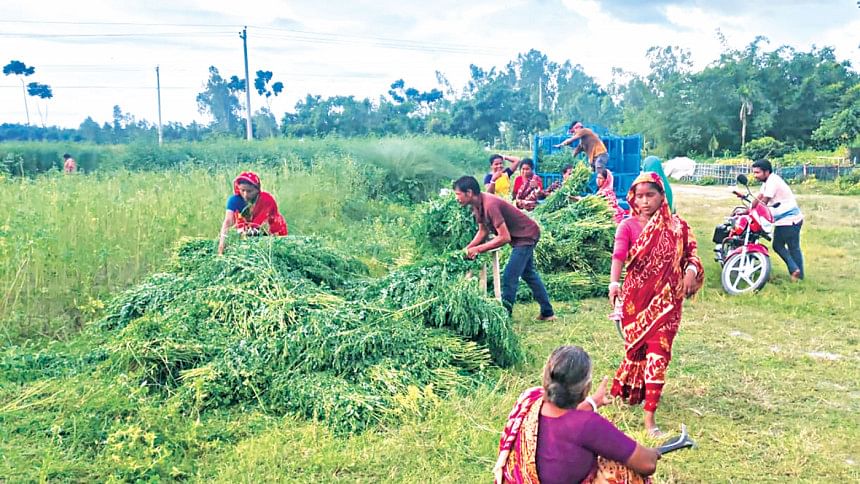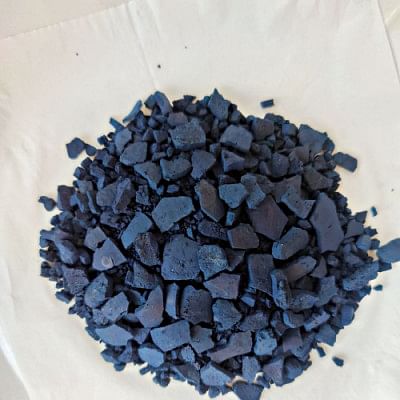Indigo farming moving towards promising future


The history of indigo farming under British rule is still cause for indignation among many in Bangladesh as it reminds of the tyranny faced in having to cultivate the plant in place of food crops.
Originating in the Middle East, the indigo plant was once so scarce that the eponymous colour extracted from its leaves became associated with wealth and power, driving up demand among affluent people.
Additionally, the natural dye made from indigo is particularly suitable for colouring cotton garments, making it a profitable industry that helped the British consolidate their hold on the Indian subcontinent.
However, indigo farmers in the main growing region comprising Bangladesh and West Bengal were paid unfairly low prices for the shrub as the European colonists had monopolised its cultivation.
Under these greatly unfavourable conditions, a prolonged famine that claimed millions of lives ensued until the farmers finally rose against their British plantation owners in the Indigo Rebellion of 1859-60.
And although the movement had helped effect positive change in the industry, the advent of synthetic dye coupled with the need for more essential crops effectively put an end to indigo cultivation.
Now though, indigo farming is showing signs of recovery in Bangladesh as some farmers in Rangpur and Nilphamari are cultivating the plant on a small scale.
Known as Malgas to locals, they use the plant's leaves as compost to increase soil fertility while the stalks and branches are burnt as fuel.

Still, cultivating indigo for its original purpose could help the country tap into a multi-million-dollar business as the use of natural dyes is increasing worldwide amid growing health awareness.
Studies have shown that some synthetic dyes could be health hazardous while natural dyes are non-toxic and environment-friendly for being made from sustainable sources.
The indigo plant was "rediscovered" in Bangladesh by Indian consultant Tushar Kumar, who came to work in the country under a CARE Foundation project in Rangpur back in 2006.
Inspired by his success at growing indigo, a US-based NGO called the Mennonite Central Committee arranged training for local farmers on how to extract dye from the plant that same year.
Nekhil Chandra Ray, a resident of Horkoli Thakurtari village in Gangachara upazila of Rangpur who received the training, has since emerged as a pioneer in producing indigo dye.
"I set up a dyeing factory on 37 decimals of land along the Dinajpur-Rangpur-Dhaka highway," he said, adding that the industry is facilitating growth in his area by providing employment opportunities.
For example, some 720 farmers from villages in Rangpur and Nilphamari are now contracted by Nekhil's factory to grow indigo on about 1,000 bighas of land.
Moksed Ali of Parhat village in Kishoreganj upazila of Nilphamari said he cultivates indigo on one acre of land to produce 3,000 kilogrammes of leaves, which sell for about Tk 5 per kilogramme (kg).
Abdul Hye, a farmer of Balabari village in Taraganj upazila of Rangpur, said he sowed a kilogramme of indigo seeds in April and harvested the plant in August without any use of fertilisers or irrigation.
Nekhil's factory currently employs about 100 workers, who are paid Tk 250 daily.
He explained that about 300 kgs of leaves are required to produce a single kilogramme of dye at a cost of about Tk 3,000 to Tk 3,500.
The dye is then sold for between Tk 5,000 and Tk 8,000 per kg depending on quality.
The demand for Nekhil's dye has been increasing as its quality was certified by Bangladesh Council of Scientific and Industrial Research (BCSIR) on February 28 earlier this year.
Khabiruddin Sarker, senior scientific officer of the BCSIR, said the sample provided by Nekhil showed that it is a good natural dye that is suitable for use in making fabrics and textiles.
As a result, a few other entrepreneurs joined hands with Nekhil to form a joint stock company called "Indigo Fields Ltd" that aims to once again popularise the natural dye at home and abroad.
At present, India, China Vietnam and El Salvador are the only major dye exporters, leaving ample opportunity for Bangladesh to join the competition, he added.
Khabiruddin also said that prominent trading firms, exporters and NGOs such as Aarong, Probortona, Esquire, The Source and Nodi Limited regularly collect indigo dye from Nekhil's factory.
Moklesur Rahman, a senior manager of Nodi, said they source indigo dye from Nekhil's factory to colour export-orient garment items that are free of health hazards.
"Local garments units import synthetic dyes for millions of dollars each year. If those are replaced by locally produced natural dye, our country could save a huge amount of foreign currency," he added.
Living Blue, another prominent dye producer co-owned by Care Enterprise Inc and Nijera Cottage and Village Industry, has also been working in this field since 2006.
The company exported one tonne of indigo dye to the US in 2018, which was the largest shipment of its kind from the country.
However, Living Blue has had to cease its activities after facing setbacks during coronavirus pandemic.

 For all latest news, follow The Daily Star's Google News channel.
For all latest news, follow The Daily Star's Google News channel. 





Comments